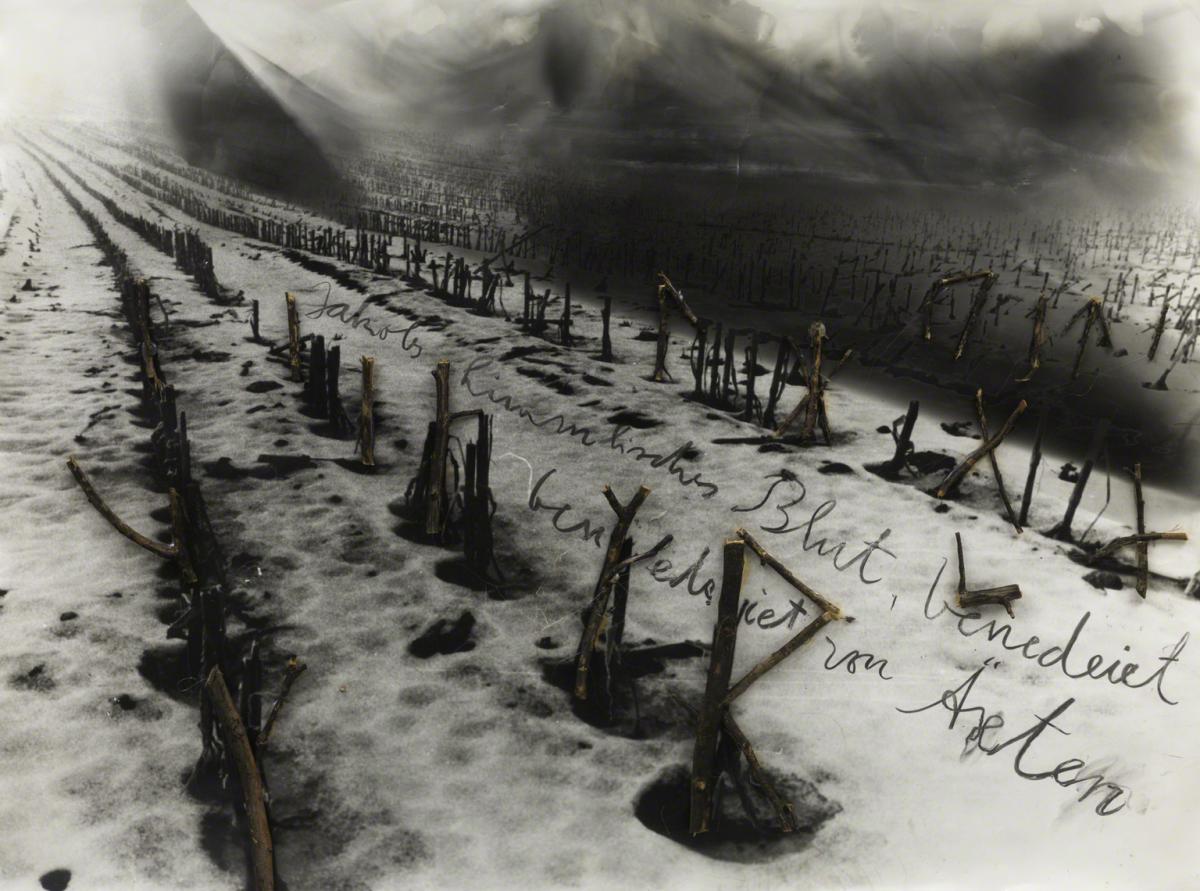Jakobs himmlisches Blut benedeiet von Äxten (Jacob’s Heavenly Blood Blessed by Axes)
Anselm Kiefer ( 2005 )

The image is heartrending. A devastated, frozen landscape, the perspective entirely warped to the left, dominated by a disobedient vanishing point. It is an optical illusion that is incapable of containing a habitable space; the image of a place with no harvest, farmland with no future.
In a landscape of infinite mourning, suffering rolls across the image of scorched trunks that are wrapped around other, real trunks. Crucified, in fact, upon them. A hybrid print that produces a new visual labyrinth and bears the guilt and atonement of a culture that has razed its logocentric edifice. Light no longer prevails, but rather becomes a thick smoke that obscures any gaze. Next comes a snowfall of ash, ash from the incineration of Shulamith, the Jewish woman evoked by Paul Celan in “Todesfuge” (Death Fugue). But Shulamith is no longer there; she has been engulfed by a ruthless night. In her place is Jacob, son of Isaac, grandson of Abraham, father of Joseph.
The title of Kiefer’s collage alludes to Hebrew antiquity, to blood and steel, and it does not forget that death is a master from Germany, as described by Celan, a poet who wrote in the language of the enemy and whose work is critical to understanding Kiefer’s mind.
your golden hair Margareteyour ashen hair Shulamith he plays with the serpents [1].
Meanwhile, the land remains a coagulated void, unsettled by a flurry of blackness. We can hear the woodworms in those trunks affixed to the photo. The linearity of time is nothing more than an accumulation of expectations. Jacques Ranciere says that there are no stories.[2] They were all told in the Old Testament. We are in the time after all stories. Now is not the time to craft beautiful phrases to compensate for the emptiness of all waiting, but the time to take an interest in the wait itself. It is a time of absence and desolation that doesn’t allow us to expect anything from the landscape. In fact, we are no longer able to even occupy it, as it has ceased to be a place at all; it has become a void. That void has fallen silent; its sound is a merciless, smoky wind that batters what remains of the landscape as its absence spreads. As it spreads, it blankets that absence, because the experience of silence is the experience of delayed death. That silence is an avaricious mirror that shows us not the image of absence, but the image of death, which, ultimately, are one and the same. This piece, guilty with the heritage of horror, is grounded in a return to Jewish mysticism and Kabbalah. Painting is the epic from trauma. But this work, too, spares us the anecdotal. It retains its icy beauty in the storehouse of the visible, just before the epiphany. The question is: where will the white go when the snow melts?
1. Paul Celan, “Fugue of Death” (first published 1948; reprinted 1952), translation by Christopher Middleton, https://poets.org/poem/fugue-death.
2. Jacques Ranciere, Béla Tarr, The Time After (Minneapolis: University of Minnesota Press, 2015), 63.
Text by Bernardí Roig, from Seeing Differently: The Phillips Collects for a New Century (The Phillips Collection in association with Giles, 2021)